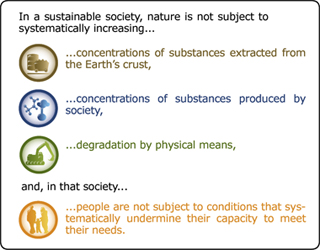4 Reasons It’s Time to Raise the Standards Bar for Companies
 Thank you to Bob Willard—a Member of The Natural Step Canada’s Board of Directors and a true giant among sustainability thought leaders—for this inspiring and thought provoking piece. Please read his latest blog below and visit his web site, Sustainability Advantage, to learn more. Indeed, Bob, let’s raise the bar!
Thank you to Bob Willard—a Member of The Natural Step Canada’s Board of Directors and a true giant among sustainability thought leaders—for this inspiring and thought provoking piece. Please read his latest blog below and visit his web site, Sustainability Advantage, to learn more. Indeed, Bob, let’s raise the bar!
***
How would we recognize a sustainable enterprise if we saw one? That question has been nagging at me for years. When we celebrate companies ranked as being the most sustainable (see my April 5, 2011, blog: 5 Lists of the Most Sustainable Companies), are they really just the best of a bad lot? When a company is certified as making significant progress towards its aspirational sustainability-related goals (see my April 19 blog: 5 Reasons ULE 880 is a Bellwether Sustainability Standard), are those goals setting the bar high enough?Are we ready for a more rigorous assessment of where Mother Earth would position a company on its journey toward being a truly sustainable enterprise? I think so, for four reasons.
First, we have the criteria. The Natural Step (TNS) has helped us enormously. Its founder, Dr. Karl-Henrik Robèrt orchestrated a consensus among scientists on the four conditions that are necessary for a sustainable society. As a by-product of the TNS effort, scientists defined what organizations must do to help achieve and maintain that society. That is, they have defined sustainable enterprises as ones which meet the four high-level, strategic conditions in the adjacent slide.
 The four principles are wonderfully succinct. They say that a sustainable company is one that cleans up its act, neutralizes its environmental and social impacts, and leaves the world the way it found it, or better. It achieves net zero energy, net zero waste, net zero water, net zero pollution, net zero materials—net zero everything. At least. And it steps up to the gnarly issue of economic and social justice to ensure more equitable attainment of a high quality of life for its stakeholders. The World Business Council for Sustainable Development (WBCSD) has a helpful Vision 2050 set of documents that graphically describes paths to this future state.
The four principles are wonderfully succinct. They say that a sustainable company is one that cleans up its act, neutralizes its environmental and social impacts, and leaves the world the way it found it, or better. It achieves net zero energy, net zero waste, net zero water, net zero pollution, net zero materials—net zero everything. At least. And it steps up to the gnarly issue of economic and social justice to ensure more equitable attainment of a high quality of life for its stakeholders. The World Business Council for Sustainable Development (WBCSD) has a helpful Vision 2050 set of documents that graphically describes paths to this future state.
Second, we have a great standard on which to build. A new principle-based standard could be modeled on the emerging ULE 880 standard. We just need to replace companies’ aspirational goals relative to 2005 with more absolute goals relative to the four systems conditions for a sustainable enterprise. Any time-based goals would reflect what scientists in that goal’s area of expertise say we need to achieve by the specified date. Another candidate for the base would be the certification criteria for B Corps (see my February 8, 2011 blog, A Better Business Model: B Corporations).
Third, a more rigorous, principle-based standard addresses multiple needs:
- We need to encourage innovative breakthrough thinking by helping companies realize how far they have to go to be sustainable enterprises. Stretch goals energize creative thinking.
- We need to set the bar high and avoid lulling companies into thinking that they are already doing enough, or that there is no urgency to do more.
- We need to applaud leading companies who aspire to being truly sustainable enterprises, while acknowledging how much more needs to be done.
- We need to spark transformational approaches to being good companies, not incremental approaches toward being less bad.
- We need a Gold-standard for truly sustainable companies. It would make greenwashing claims even more embarrassing, and level the playing field.
Fourth, the world is ready for this kind of standard. Influential companies like Wal-Mart, P&G, and Caterpillar have declared zero-waste goals. California has introduced legislation that requires all new commercial buildings to be zero-net-energy (ZNE) by 2030, and new residential buildings to be ZNE by 2020. InterfaceFLOR is on track to climb “Mount Sustainability” by 2020. Leading companies are ready.
Why are we hesitant to create this standard? Maybe it’s because companies in high-impact sectors would be discouraged or traumatized when they see how far they still have to go on their sustainability journeys. Maybe they will think it is unfair to use a standard that reveals how today’s business model prevents some companies in some sectors from ever being truly sustainable. Maybe it’s because some companies would ridicule the standard as being idealistic and out of touch with their myopic reality, versus Mother Earth’s.
By setting Big Hairy Audacious Goals (BHAGs), we unleash the creativity and innovation of impassioned sustainability champions to help us achieve the necessary quantum leaps. We may need new technologies, new business models, and new corporate purposes. Visions are inspiring and energizing. When President Kennedy announced his famous vision in 1961, he had no idea how the U.S. could land a man on the moon within 10 years and return him safely to earth. But he had faith in the ingenuity of the best and brightest people to do the impossible. They did it. So can we, if set our sights high enough.
- Log in to post comments

